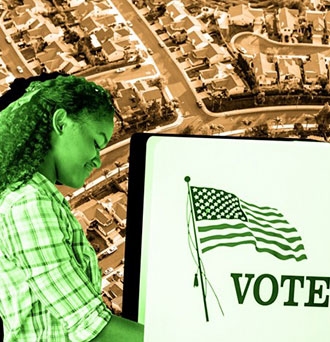
Tom Bradley likely felt comfortable that he would be California’s next governor in November 1982. The race was the most expensive gubernatorial campaign in the state’s history, and it had gotten dirty. But the popular Black mayor and Democratic nominee, the first African-American to head a California gubernatorial ticket, had an impressive 14-point early lead against Republican attorney general George Deukmejian. And although that lead shrunk substantially in the run-up to Election Day, pollsters still picked him as the favorite.
So it was with some head scratching that Deukmejian was announced the winner, with 49.3 percent of the vote. Pollsters had some explaining to do. One popular answer given for the miscalculation was that some White voters didn’t admit they would be voting for the White candidate because they were worried about being accused of racism. Political scientists call that a “social desirability bias” — in other words, people were ashamed of their actual voting intentions, so they fibbed.
While social desirabilities of Americans have likely changed — some researchers saw what they labeled a “reverse Bradley effect” in 2008 when Barack Obama was elected — the value placed on voting remains high enough to lie about. But the modern version is more about the shame of not voting at all.
In fact: according to a 2018 study by the environmental voter project, 78 percent of respondents overreported their voting histories.
Pollsters from the environmental nonprofit called some 8,500 registered voters in four states in 2017, asking questions about their records. Did they vote for president? What about in the midterms or local elections? They then compared the answers to each respondent’s public voter files.
Their findings point to an enormous social desirability bias with respect to voting, says Nathaniel Stinnett, executive director of the EVP. “Even people who don’t vote, or who rarely vote, still want to be known as good voters,” he says. In this case, it’s not about where your vote goes; it’s that it’s shameful not to participate in elections — a new taboo for the modern age.
And this concept is backed up by even earlier research. A seminal study by researchers from Yale University in 2008 showed an 8.1 percent increase in turnout for people who were told their voting record would be shared with their neighbors. Get-out-the-vote groups were quick to make use of the data.
By appealing to a voter’s idealized version of themselves — as a good citizen who makes the time to vote — campaigners can nudge people to the booth on Election Day, says Stinnett. “That space in between those two versions of ourselves offers a lot of really powerful opportunities for behavior change,” he says. His nonprofit — rather than bring up arguments on policy — finds environmentalists who aren’t good voters and tries to get them to change through pledges and data on their neighbors’ voting records.
Republican Sen. Ted Cruz of Texas took this to another level in 2016 when his campaign almost replicated the 2008 Yale study. To increase turnout for the Republican caucus, Cruz sent Iowans a mailer with the heading “Voting Violation.” The document purported to show that the person’s voting record, as well as their neighbors’, and not-so-subtly reminded them to vote. Cruz won the caucus that year.
It’s unclear if this effect is changing, as studies are still young. Voter turnout in the U.S. has fluctuated for presidential elections since 1918, with a high of 63.8 percent in 1960 and a low of 48.9 percent in 1924. In 2016, it was 61.4 percent, but the 2018 midterm elections saw a turnout of 47.5 percent, the highest turnout for a midterm since 1966. It’s also hard to compare international conceptions of voting as a civic duty, though the U.S. ranks relatively low among peers when it comes to turnout. According to the Pew Research Center, the U.S. placed 26th out of 32 Organization for Economic Cooperation and Development countries. Last year’s midterm elections saw a surge in voters who were under 40 and over 65 compared to the 2014 midterm elections. It also saw a larger percentage of the electorate made up of suburbanites with college degrees.
To be sure, measures in many states in recent years have made it more difficult for certain demographics to vote. While those of college age have a reputation as politically engaged — and 31 percent voted in 2018, the highest turnout in 25 years — they’ve had to fight against other barriers. These include things like having to choose between antiquated absentee voting processes or stringent ID requirements in states like New Hampshire, where they have to switch to a New Hampshire driving license to vote, and in Texas, where student ID cards don’t count as identification for voting purposes.
The “shy voter” — or social desirability bias — was partially blamed by some experts for the surprise win for “leave” in the Brexit referendum of 2016. The argument for this sounds similar to that made about Tom Bradley’s case in 1982: Voters didn’t tell pollsters how they would vote for fear of being seen as racist or intolerant.
Stinnett doesn’t actually think people walk around carrying a deep shame of not voting. Rather, it’s just that people want others to think they are better citizens than they are. And because using that feeling has been effective in getting people to vote, don’t expect it to stop anytime soon. It may get even more intense: Last year saw the release of OutVote and VoteWithMe, apps that encourage people to inspect their friends’ voting data, then text to remind (or shame) them to cast a ballot.
